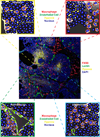Differential macrophage programming in the tumor microenvironment
- PMID: 22277903
- PMCID: PMC3294003
- DOI: 10.1016/j.it.2011.12.001
Differential macrophage programming in the tumor microenvironment
Abstract
Of the multiple unique stromal cell types common to solid tumors, tumor-associated macrophages (TAMs) are significant for fostering tumor progression. The protumor properties of TAMs derive from regulation of angiogenic programming, production of soluble mediators that support proliferation, survival and invasion of malignant cells, and direct and indirect suppression of cytotoxic T cell activity. These varied activities are dependent on the polarization state of TAMs that is regulated in part by local concentrations of cytokines and chemokines, as well as varied interactions of TAMs with normal and degraded components of the extracellular matrix. Targeting molecular pathways regulating TAM polarization holds great promise for anticancer therapy.
Copyright © 2012 Elsevier Ltd. All rights reserved.
Figures


References
Publication types
MeSH terms
Grants and funding
LinkOut - more resources
Full Text Sources
Other Literature Sources

